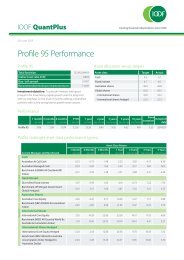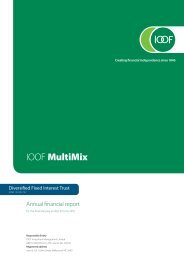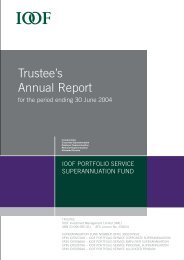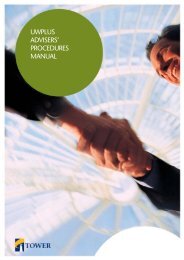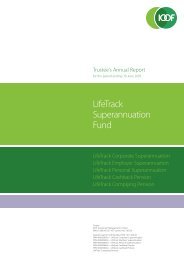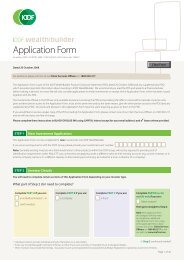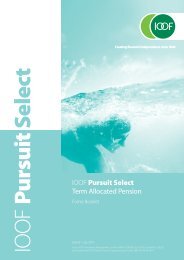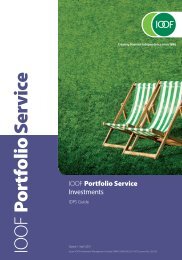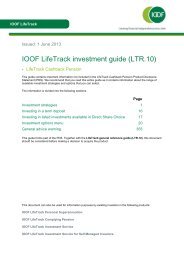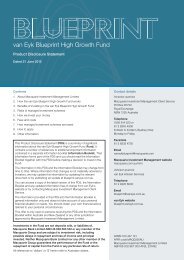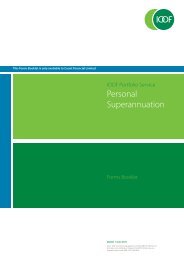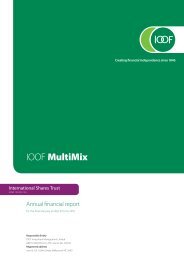annual report 2011
annual report 2011
annual report 2011
Create successful ePaper yourself
Turn your PDF publications into a flip-book with our unique Google optimized e-Paper software.
IOOF | <strong>annual</strong> <strong>report</strong> <strong>2011</strong><br />
5 Risk management<br />
IOOF risk management framework<br />
Risk is defined by IOOF as any event which hinders the<br />
sustainable achievement of Group objectives and results,<br />
including a failure to exploit opportunities. The Group’s<br />
strategy to manage risk involves the identification of risks by<br />
type, impact and likelihood, implementation of controls to<br />
mitigate risks, and continuous monitoring and improvement of<br />
the procedures in place.<br />
The Group’s objective is to satisfactorily manage its risks in<br />
line with the Group’s Risk Management Policy set by the<br />
Board, and this aligns to International Standard ISO 31000<br />
Risk Management. Procedures are put in place to control and<br />
mitigate the risks faced by the Group and vary depending<br />
on the nature of the risk. The Group maintains a framework<br />
to ensure regulatory compliance obligations are managed<br />
in accordance with Australian Standard 3806 Compliance<br />
Programs. The Group’s exposure to all material risks is<br />
monitored by the Head of Risk and this exposure, and any<br />
anticipated risk exposure, is regularly <strong>report</strong>ed to the Risk and<br />
Compliance Committee, and the Board.<br />
The Group’s income and operating cash flows are indirectly<br />
impacted by changing market conditions. Its exposure is<br />
through the impact of market changes on the level of funds<br />
under management and administration, and consequently<br />
management fee and service fee revenue. Information has<br />
been provided below only on the direct impact of changing<br />
market conditions to the Group’s income and operating cash<br />
flows.<br />
The financial condition and operating results of the Group are<br />
affected by a variety of financial and non-financial risks. The<br />
key non-financial exposures are to operational risk and a failure<br />
to meet regulatory compliance obligations. The nature of the<br />
financial risk exposures arising from financial instruments, the<br />
objectives, policies and processes for managing these risks,<br />
and the methods used to measure them are detailed below.<br />
Financial risk<br />
The financial risk management objectives, policies and<br />
processes and the quantitative data about the exposure to risk<br />
at the <strong>report</strong>ing date, as set out in the remainder of this note,<br />
excludes the benefit funds and the controlled unit trusts. This<br />
is because the risks associated with financial instruments held<br />
by the benefit funds and controlled trusts are borne by the<br />
policyholders and members of those funds and trusts, and not<br />
the shareholders of the Group. There is no direct impact on<br />
the net profit or the equity of the Group as a consequence of<br />
changes in markets as they apply to financial instruments held<br />
by those funds and trusts at the <strong>report</strong>ing date.<br />
Similarly the objectives, policies and processes for managing<br />
the risks of the Group are separate and distinct from those for<br />
the benefit funds and trusts. The funds and trusts are managed<br />
under extensive regulatory requirements, and in accordance<br />
with specific investment guidelines, risk management<br />
strategies, risk management plans, and product disclosure<br />
statements. The Group is managed under a set of separate<br />
corporate policies and review processes that are directed<br />
toward the interests of the shareholders of the Group.<br />
Information in relation to financial risks associated with the<br />
benefit funds and controlled trusts is available in their Product<br />
Disclosure Statements and the individual <strong>annual</strong> financial<br />
<strong>report</strong>s of those trusts.<br />
Further information in relation to the Australian Accounting<br />
Standards requirement to consolidate the benefit funds and<br />
controlled trusts in the consolidated financial statements of the<br />
Group is available in Note 3(a) Basis of consolidation.<br />
The following table shows the value of financial instruments<br />
held directly and actively managed by the corporate entities<br />
within the Group in relation to its shareholder interests. It<br />
shows the financial instruments, as <strong>report</strong>ed in the notes to the<br />
financial statements, excluding any elimination entries made<br />
upon consolidation with the funds and trusts. The adjustment<br />
of these eliminations has the effect of identifying the interentity<br />
financial instruments that are also actively managed by<br />
the Group.<br />
page 67



